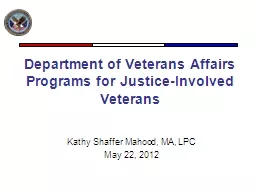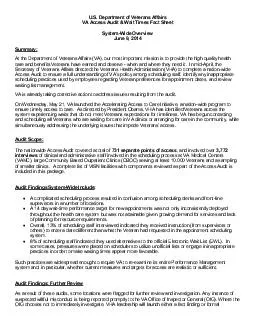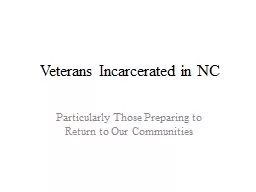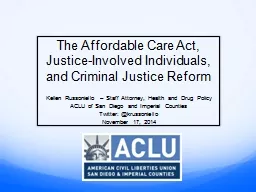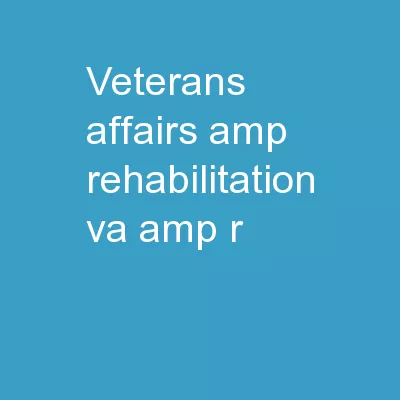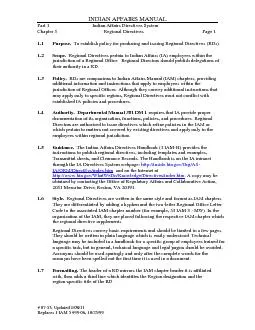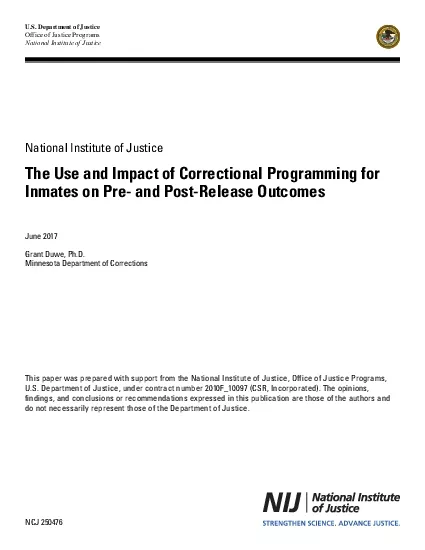PPT-Department of Veterans Affairs Programs for Justice-Involved Veterans
Author : test | Published Date : 2018-10-14
Kathy Shaffer Mahood MA LPC May 22 2012 Veterans Integrated Service Network VISN 4 Defining JusticeInvolved Veterans A justiceinvolved Veteran is A Veteran in contact
Presentation Embed Code
Download Presentation
Download Presentation The PPT/PDF document "Department of Veterans Affairs Programs ..." is the property of its rightful owner. Permission is granted to download and print the materials on this website for personal, non-commercial use only, and to display it on your personal computer provided you do not modify the materials and that you retain all copyright notices contained in the materials. By downloading content from our website, you accept the terms of this agreement.
Department of Veterans Affairs Programs for Justice-Involved Veterans: Transcript
Kathy Shaffer Mahood MA LPC May 22 2012 Veterans Integrated Service Network VISN 4 Defining JusticeInvolved Veterans A justiceinvolved Veteran is A Veteran in contact with local law enforcement who can be appropriately diverted from arrest into mental health or substance abuse treatment. S Department of Justice Office of Justice Programs Bureau of Justice Statistics Bureau of Justice Statistics Statistical Tables October 2010 NCJ 231679 Background Checks for Firearms Transfers 2009Statistical Table S Department of Veterans Affairs VA Access Audit Wait Times Fact Sheet System Wide Overview June 9 2014 Summary At the Department of Veterans Affairs VA our most important mission is to provide the high quali S Department of Justice Office of Justice Programs Bureau of Justice Statistics Bureau of Justice Statistics September 2010 NCJ 227379 Special Report Highlights National Crime Victimization Survey Victimization Duri for Institutional Review Boards. Jane Gutcher. Office of General Counsel. Ethics Specialty Team. August 14, . 2012. Training Topics. Introductory. slides. Applying rules to IRB members as Federal employees. TRANSITIONAL HOUSING PROGRAMS FOR HOMELESS VETERANS. 2 Facilities. Veteran’s Haven North. New . Jersey Department of Military and Veterans Affairs. “The Rally Point”. Veteran’s Haven South. New Jersey Department of Military and Veterans Affairs. Particularly Those Preparing to Return to Our Communities. 2. Background. In 2000, the U.S. Department of Justice estimated that 12% of those incarcerated in jails and prisons were veterans . 80% of those veterans were eligible for VA services. . for Institutional Review Boards. Jane Gutcher. Office of General Counsel. Ethics Specialty Team. August 14, . 2012. Training Topics. Introductory. slides. Applying rules to IRB members as Federal employees. House State Government Finance Committee. February 24, 2011. 1. Minnesota Department of . Veterans Affairs. Comprehensive Five Year Strategic Plan, with 2010 Update http://www.mdva.state.mn.us/reports/index.htm#StrategicPlan . Kellen Russoniello – Staff Attorney, Health and Drug Policy. ACLU of San Diego and Imperial Counties . Twitter: @. krussoniello. November 17, . 2014 . ACLU of San Diego and Imperial Counties. We fight for individual rights and fundamental freedoms for all through education, litigation, and policy advocacy. “The natural spokesman for the disabled veteran, his first friend and advocate, is his veterans organization.”. - Richard Seeyle Jones, “A History of The American Legion,” 1946. Aaron Cunningham, VA&R Chairman . .1 Purpose.To establish policy for producing and issuing Regional Directives (RDs). http://inside.bia.gov/Org/AS- IA/ORM/DirectSys/index.htm and on the Internet at http://www.bia.gov/WhatWeDo/Knowle National Institute of Justice The Use and Impact of Correctional Programming for Inmates on Pre- and Post-Release Outcomes June 201731 Grant Duwe PhD31 Minnesota Department of Corrections31 This paper Brent J. Cohen. Office of Justice Programs. U.S. Department of Justice. Correctional Education Guidance Package. A . set of . Guiding Principles for Providing High-Quality Education in Juvenile Justice Secure Care Settings. Department of Veterans Affairs. Completed Summer 2021. FY21 Capacity Assessment Reflection Summary. 2. What we’re proud of this year:. VHA has approved a five-year enterprise-wide plan for Patient Experience that will act as the strategic...
Download Document
Here is the link to download the presentation.
"Department of Veterans Affairs Programs for Justice-Involved Veterans"The content belongs to its owner. You may download and print it for personal use, without modification, and keep all copyright notices. By downloading, you agree to these terms.
Related Documents

